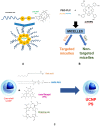Development of Novel Tetrapyrrole Structure Photosensitizers for Cancer Photodynamic Therapy
- PMID: 35200435
- PMCID: PMC8868602
- DOI: 10.3390/bioengineering9020082
Development of Novel Tetrapyrrole Structure Photosensitizers for Cancer Photodynamic Therapy
Abstract
The effectiveness of photodynamic therapy (PDT) is based on the triad effects of photosensitizer (PS), molecular oxygen and visible light on malignant tumors. Such complex induces a multifactorial manner including reactive-oxygen-species-mediated damage and the killing of cells, vasculature damage of the tumor, and activation of the organism immunity. The effectiveness of PDT depends on the properties of photosensitizing drugs, their selectivity, enhanced photoproduction of reactive particles, absorption in the near infrared spectrum, and drug delivery strategies. Photosensitizers of the tetrapyrrole structure (porphyrins) are widely used in PDT because of their unique diagnostic and therapeutic functions. Nevertheless, the clinical use of the first-generation PS (sodium porfimer and hematoporphyrins) revealed difficulties, such as long-term skin photosensitivity, insufficient penetration into deep-seated tumors and incorrect localization to it. The second generation is based on different approaches of the synthesis and conjugation of porphyrin PS with biomolecules, which made it possible to approach the targeted PDT of tumors. Despite the fact that the development of the second-generation PS started about 30 years ago, these technologies are still in demand and are in intensive development, especially in the direction of improving the process of optimization split linkers responsive to input. Bioconjugation and encapsulation by targeting molecules are among the main strategies for developing of the PS synthesis. A targeted drug delivery system with the effect of increased permeability and retention by tumor cells is one of the ultimate goals of the synthesis of second-generation PS. This review presents porphyrin PS of various generations, discusses factors affecting cellular biodistribution and uptake, and indicates their role as diagnostic and therapeutic (theranostic) agents. New complexes based on porphyrin PS for photoimmunotherapy are presented, where specific antibodies are used that are chemically bound to PS, absorbing light from the near infrared part of the spectrum. Additionally, a two-photon photodynamic approach using third-generation photosensitizers for the treatment of tumors is discussed, which indicates the prospects for the further development of a promising method antitumor PDT.
Keywords: cancer; photodynamic therapy; photosensitizers; porphyrins; properties; tetrapyrrole structure.
Conflict of interest statement
The authors declare no conflict of interest.
Figures



References
Publication types
LinkOut - more resources
Full Text Sources

